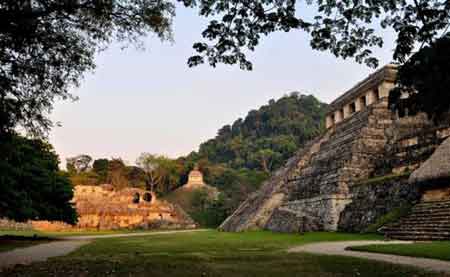随着2011年进入最后一个月,关于古玛雅人2012年世界末日的预言在互联网上再度风传。为了破除谣传,墨西哥国家人类学和历史研究所近日在墨西哥南部的帕伦克玛雅遗址举行圆桌会议,邀请了全球60名研究玛雅文化的专家出席。专家们一致认为,2012年只是玛雅长纪年历中一个时代的结束,但这并不意味着世界末日。人类距离世界毁灭还远得很,专家说明对于所谓世界末日的说法和所有此类担忧都是杞人忧天。

|
 |
|
Tomb of a Mayan ruler at the ruins of the Mayan city of Palenque in the hills of the southern Mexican state of Chiapas in a photo by the National Institute of Anthropology and History (INAH) released June 23, 2011. |
If you are worried the world will end next year based on the Mayan calendar, relax: the end of time is still far off.
So say Mayan experts who want to dispel any belief that the ancient Mayans predicted a world apocalypse next year.
The Mayan calendar marks the end of a 5,126 year old cycle around December 12, 2012 which should bring the return of Bolon Yokte, a Mayan god associated with war and creation.
Author Jose Arguelles called the date "the ending of time as we know it" in a 1987 book that spawned an army of Mayan theorists, whose speculations on a cataclysmic end abound online. But specialists meeting at this ancient Mayan city in southern Mexico say it merely marks the termination of one period of creation and the beginning of another.
"We have to be clear about this. There is no prophecy for 2012," said Erik Velasquez, an etchings specialist at the National Autonomous University of Mexico (UNAM). "It's a marketing fallacy."
The National Institute of Anthropological History in Mexico has been trying to quell the barrage of forecasters predicting the apocalypse. "The West's messianic thinking has distorted the world view of ancient civilizations like the Mayans," the institute said in a statement.
In the Mayan calendar, the long calendar count begins in 3,114 BC and is divided into roughly 394-year periods called Baktuns. Mayans held the number 13 sacred and the 13th Baktun ends next year.
Sven Gronemeyer, a researcher of Mayan codes from La Trobe University in Australia, who has been trying to decode the calendar, said the so-called end day reflects a transition from one era to the next in which Bolon Yokte returns.
"Because Bolon Yokte was already present at the day of creation ... it just seemed natural for the Mayan that Bolon Yokte will again be present," he said.
Of the approximately 15,000 registered glyphic texts found in different parts of what was then the Mayan empire, only two mention 2012, the Institute said.
"The Maya did not think about humanity, global warming or predict the poles would fuse together," said Alfonso Ladena, a professor from the Complutense University of Madrid. "We project our worries on them."
相关阅读
(Agencies)

(中国日报网英语点津 Rosy 编辑)